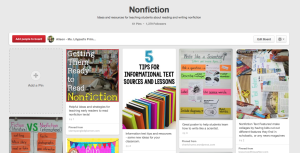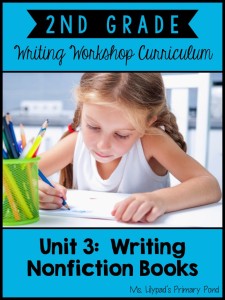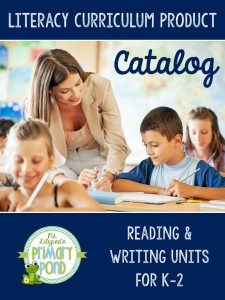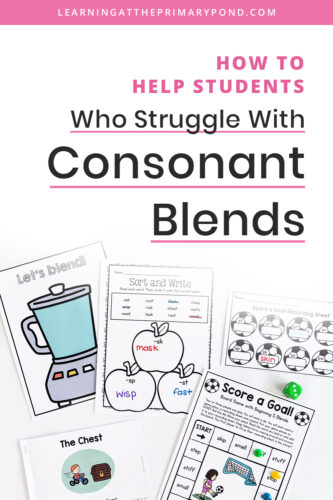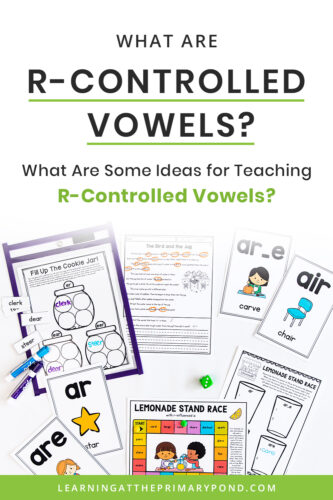If you follow my blog, you already know that I love, love, love teaching writing. And one of my favorite genres to teach is nonfiction. Kids love being “experts” and sharing what they know about a topic! However, when I first started teaching, I hit somewhat of a roadblock when teaching nonfiction. I would teach kids what nonfiction was…read nonfiction mentor texts aloud to them…even have them create text features like captions and a table of contents. But all of that “stuff” takes maybe a week or a week and a half to teach. Then, I would find myself asking…”Now what?” At that time, I just didn’t have enough ideas about what to teach when teaching nonfiction writing.
It probably would’ve helped if I’d had a schoolwide writing curriculum to give me some more ideas for lessons! But…I didn’t at that time. So I started searching. I consulted teacher books, looked at excellent nonfiction books for kids, thought more about what good writers of nonfiction do, and just generally tried to dig deeper into nonfiction writing. Over time, I came up with lessons to help kids go above and beyond the basics. Here are my ideas – they certainly aren’t crazy-unique, but maybe you can at least take an idea or two away!
Teach a lesson about…
– Writing an introduction that “hooks” the reader: Kids tend to launch into writing nonfiction or “all about” books by throwing facts at the reader. Teach them to slow down and introduce their topic, perhaps by giving an interesting fact to hook the reader. One way to do this is to model writing several different possible introductions for a nonfiction book, and then letting the kids choose their favorite.
– Writing a conclusion that explains why the topic should matter to the reader: Just like their beginnings, kids tend to write endings to their nonfiction books that are somewhat abrupt. Teach your students to wrap up their writing with a conclusion. One great way to do this is to show them how to remind the reader why their topic matters, and what they should most remember about the information presented in the book. Here are some brief examples:
Now you know how important is to recycle. Talk to your family or school about recycling today!
If you think that a hamster would be a good pet for you, teach your family about what hamsters eat, what toys they like, and how to care for them. Maybe you can ask them to take you to a pet shop and look at hamsters!
Now you know about how amazing whales are. Do your part to take care of the ocean habitats where they live!
Of course, your average 6 year old probably isn’t going to come up with something like this independently – but if you model writing conclusions like these, then eventually the kids will move closer toward writing strong conclusions.
– Creating text features: There are so many different options here! Kids can make a table of contents, headings, a glossary, detailed pictures with captions and labels, etc. Make sure that your students are already very familiar with lots of examples of text features from published nonfiction books before you ask them to include text features in their own writing.
– Expanding sentences with adjectives: Teaching nonfiction writing is a great time to teach kids how to expand sentences with adjectives! Instead of “Elephants have ears,” teach them to write, “Elephants have large, flat ears.”
– Including examples: Explicitly teach kids how to give examples and use the word “examples” with them. Instead of “Giraffes eat plants,” teach them to write, “Giraffes eat plant parts. For example, they eat tree leaves, bark, and flowers.” Wait…do giraffes eat bark? Not sure about that one. You might want to check my facts on that one, haha.
– Making comparisons: Teach them the sentence structures “as big as,” “smaller than,” “larger than,” “slower than,” “faster than,” etc. Just how big is a daddy long legs? Is it bigger than a ladybug? Smaller than a tarantula?
One other thing I want to mention is the value of having kids do research for their nonfiction writing. Writing “all about” books can get old after a while, since young kids tend to finish books so quickly. Even if kids can’t read the words of nonfiction books, they can still use them and “read the pictures!” Think about how much information a child can get from a picture of an elephant bathing itself in the river. From that one picture, the child can learn and write about an elephant’s body parts, daily activities (bathing in the river), and what it uses its trunk for. When children are slightly older, they can read books on their own or reread books read aloud in class to gather information and check spellings of content area words.
If you are looking for more ideas on teaching kids how to read and write nonfiction, follow my Pinterest board here:
And if you’re looking for Kinder, first, or second grade nonfiction writing units that are all planned out for you, click on any of the images below!



